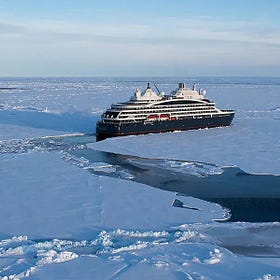Finland's Icebreaking Season Ends
Otso returned to port today, ending an exceptionally long season.

May 31, 2024: As I write this, Finnish icebreaker Otso has just moored at her summer berth in Helsinki. Despite an average ice season (based on the maximum extent of ice coverage), all of Finland’s icebreakers— eight operated by Arctia, and two icebreaking tugs chartered from Alfons Håkans— took to sea for the 2023-2024 season, something that occurs only about 1-2 times in a decade.

An Exceptionally Long Season
According to a post (original in Finnish) by the Finnish Transport Infrastructure Agency (known in Finnish as Väylävirasto):
The past icebreaking season started exceptionally early, on 23.11.2023, when Kontio was the first icebreaker to leave for the Bay of Bothnia. The last icebreaker to return to Katajanokka will be the icebreaker Otso on 31.5.2024. The length of the icebreaking season was thus 191 days. In the Gulf of Finland, the icebreaking season began on 4.1. and lasted until 9.4., a total of 97 days.
The icebreakers had a of 1,142 operating days, although two icebreakers were out of operation for a total of 22 days due to strikes in early spring. The actual figure could therefore be 1 164. In the previous season, 2022–2023, there were only 684 operating days.
In total, the icebreakers traveled about 86,000 nautical miles (44,789 in the previous season) during the season, which is about 159,000 km, or almost four times around the Earth….
During the period, a total of 2,234 vessels were assisted in the sea area, of which 428 involved towing. In the previous season 2022–2023, there were a total of 1,233 assists, of which 77 were towing.
Ice restrictions were in force from 22.11.2023, and the last ones are expected to be lifted at the turn of June. The average waiting time for assistance was 6.4 hours, but 95.8% of vessels were able to enter ports without waiting.
Arctia just released a short video covering their portion of the season:
This was a much busier season for Finland’s icebreakers than in 2022-2023, despite a less than average maximum ice coverage of 135,000km:
On average, ice covers an area of some 170 000 km², which stands for 40 % of the total Baltic Sea area (422 000 km², including Kattegatt and Skagerrak). The minimum ice extent has been on winter 2020 when there was only 37 000 km² ice in maximum. (Source: Finnish Meteorological Institute. Click through for more details on the typical ice conditions in the Baltic Sea.)
Ice Coverage Is Not a Good Predictor for Requirements:
Maximum sea ice is actually a poor predictor of icebreaking requirements, as fluctuations in temperature and wind speed play a very large role. The most challenging conditions are created by drifting pack ice which, pushed by the wind, forms challenging ridges along the coast.
Finland's eight icebreakers (operated by Arctia) and two icebreaking tugs, chartered from Alfons Håkans, are purposely designed to assist vessels in the challenging ice conditions and shallow, narrow channels in the Gulf of Bothnia and Gulf of Finland.
Two of these vessels, the Nordica and Fennica, were designed to work outside of the Baltic and have a long track record including ice management functions in Alaskan waters. Otso has also been converted for international use.
However, Finnish ship designers and shipbuilders use the lessons learned from the challenging ice conditions to design and build some of the world’s most capable polar icebreakers.
For more information on Finland’s icebreaking fleet:
Finland's Icebreakers
Note: This is part of a continuing series on Arctic policy and icebreakers. To look at previous articles, click here. Finland is the only nation in the world where all of the major ports ice up every winter. In the satellite image below, from March of 2010, you can see white ice surrounding the entirety of…
To read about but one example of a polar Icebreaker designed in Finland, see here:
A Successful Commercial Icebreaker Program: Le Commandant Charcot
During the recent Congressional Subcommittee hearing (which I wrote about here) that took a look at the delays and cost overruns of the Polar Security Cutter (PSC) program, one of the witnesses was asked to provide an example of what a good private shipbuilding design and construction program looked like. The witness could not provide an example on the…
That’s all for now!
Next week, we’ll take a virtual tour through the ‘Silicon Valley of Icebreakers’ as we look at the sites in Finland visited by a recent delegation of U.S. Navy and Coast Guard personnel.
Thanks for reading. If you like what you’ve seen, press the heart and subscribe to make sure that you never miss an update. Consider sharing with a friend or eleven; it takes me some time to research and write these articles, so I’m happy to see them spread far and wide across the net. It’s important to keep this conversation going.
Until next time.
All the Best,
PGR






Peter, as a retired shipbuilder in engineering, I find your articles very interesting. Enjoy the short summer!
Long ice-breaking season. Must be global warming.